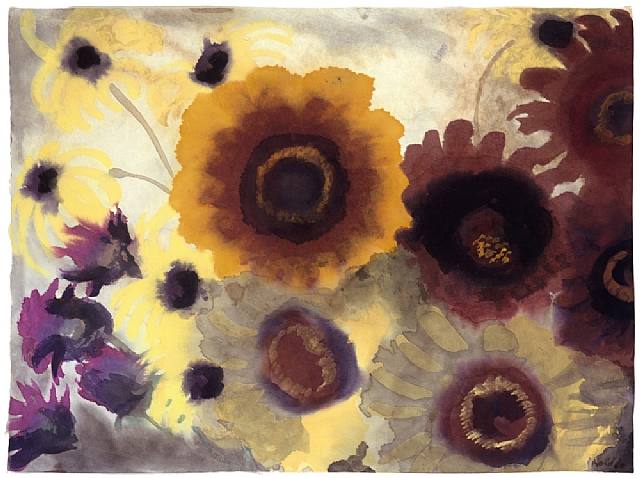Not an artist I have come across before....but I am thrilled with my tutors recommendation to go and have a look, such sumptuous colours and expressive tones and sweeping lines and strokes!
.png) |
| Wheat Field |
 |
| Stormy Sea - Emil Nolde |
Sunflowers - Emil Nolde |
Biography from Wikipedia:-
Emil Nolde was born as Emil Hansen near the village of Nolde (since 1920 part of the municipality of Burkal in Southern Jutland, Denmark), in thePrussian Duchy of Schleswig. He grew up on a farm; his parents, devout Protestants, were Frisian and Danish peasants. Between 1884 and 1888, he trained as a craftsman and worked in woodcarving, and worked in furniture factories as a young adult. In 1889, he gained entrance into the School of Applied Arts in Karlsruhe before becoming a drawing-instructor in Switzerland from 1892 to 1898, eventually leaving this job to finally pursue his dream of becoming an independent artist. As a child he had loved to paint and draw, but he was already 31 by the time he pursued a career as an artist. When he was rejected by the Munich Academy of Fine Arts in 1898, he spent the next three years taking private painting classes, visiting Paris, and becoming familiar with the contemporary impressionist scene that was popular at this time. He married Danish actress Ada Vilstrup in 1902 and moved to Berlin, where he would meet collector Gustav Schiefler and artist Karl Schmidt-Rottluff, both of whom would advocate his work later in life. He spent a brief time between 1906-1907 as a member of the revolutionary expressionist group Die Brücke (The Bridge), and as a member of theBerlin Secession in 1908-1910, but he eventually left or was expelled from both of these groups – foreshadowing of the difficulty Nolde had maintaining relationships with the organizations to which he belonged. He had achieved some fame by this time and exhibited with Kandinsky’s Der Blaue Reitergroup in 1912, supporting himself through his art.[1] From 1902 he called himself after his birthplace.
He realized his unsuitability for farm life and that he and his three brothers were not at all alike. Between 1884 and 1891, he studied to become acarver and illustrator in Flensburg. He spent his years of travel in Munich, Karlsruhe and Berlin.
Nolde was a supporter of the Nazi party from the early 1920s, having become a member of its Danish section. He expressed negative opinions about Jewish artists, and considered Expressionism to be a distinctively Germanic style. This view was shared by some other members of the Nazi party, notably Joseph Goebbels and Fritz Hippler.
However Hitler rejected all forms of modernism as "degenerate art", and the Nazi regime officially condemned Nolde's work. Until that time he had been held in great prestige in Germany. 1052 of his works were removed from museums, more than those of any other artist.[2] Some were included in the Degenerate Art exhibition of 1937, despite his protests, including (later) a personal appeal to Nazi gauleiter Baldur von Schirach in Vienna. He was not allowed to paint—even in private—after 1941. Nevertheless, during this period he created hundreds of watercolors, which he hid. He called them the "Unpainted Pictures".
In 1942 Nolde wrote:
There is silver blue, sky blue and thunder blue. Every colour holds within it a soul, which makes me happy or repels me, and which acts as a stimulus. To a person who has no art in him, colours are colours, tones tones...and that is all. All their consequences for the human spirit, which range between heaven to hell, just go unnoticed.[3]
After World War II, Nolde was once again honoured, receiving the German Order of Merit, West Germany's highest civilian decoration. He died inSeebüll (now part of Neukirchen).
Apart from paintings, Nolde's work includes many prints, often in color and watercolor paintings of various sizes, including landscapes, religious images, flowers, stormy seas and scenes from Berlin nightlife. A famous series of paintings covers the German New Guinea Expedition, visiting the South Seas, Moscow, Siberia, Korea, Japan, and China. The Schiefler Catalogue raisonné of his prints describes 231 etchings, 197 woodcuts, 83 lithographs, and 4 hectographs.
http://www.wikipaintings.org/en/emil-nolde (Accessed 1/7/2013)
http://en.wikipedia.org/wiki/Emil_Nolde (Accessed 1/7/2013)
http://www.thearttribune.com/Emil-Nolde-1867-1956.html (Accessed 1/7/2013)
No comments:
Post a Comment